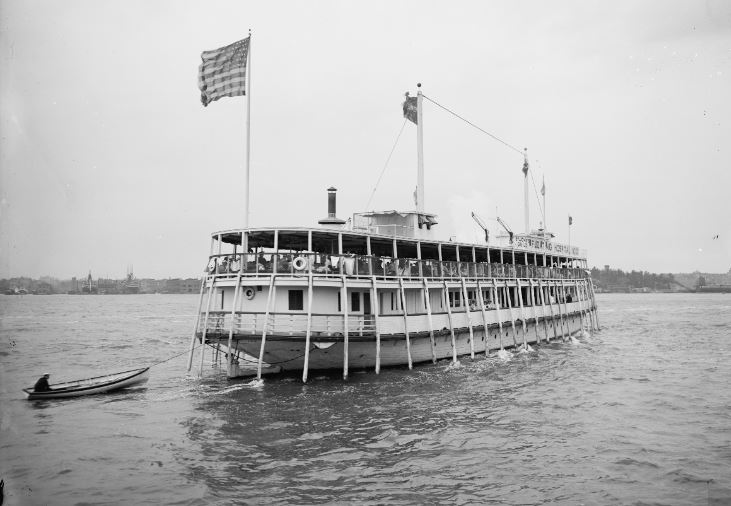|
President’s Message
June 1, 2019

Having just returned from a week long research trip to Ellis Island, I cannot help but reflect on aspects of nursing history that document the use of fresh air and sunshine as therapy. Each day of our trip, Michelle Hehman and I accessed the Island by boarding the early morning “staff” ferry for the ten-minute sail across the bay. Wind whipped the water (and our hair!) and turned my thoughts not only to keeping my balance, but also to the benefits of an excursion on the water.
The photograph above provides evidence of one venture – this one in New York City at the turn of the 20th century – that provided poor inner-city mothers and their babies day trips on the Hudson River. The purpose of the sailings: to allow the babies to “avail themselves of healthy sea breezes” and receive necessary medicines, fresh milk from clean bottles, and nutritious foods.1 Other evidence on the topic can be found in the Ellis Island archives. On Ellis island (as well as on Hoffman and Swinburne Islands) newly arrived immigrant children with infectious diseases benefitted from the breezes off the Hudson River as they recuperated from such illnesses as chickenpox, measles, diphtheria, bronchopneumonia, and scarlet fever. As one USPHS doctor remarked: “the breezes from the beautiful harbor bring a tinge of color to [the children’s] wan faces.”2
Other documentation on the benefits of fresh air is provided in Saving Sickly Children, a book on preventoriums written by one of our members, Cynthia Connolly, PhD, RN, FAAN. In this book, Dr. Connolly analyzes the care provided in the early 20th century to children at risk for developing tuberculosis. The book focusses on the preventorium in Lakewood, New Jersey, that opened in 1909, but also discusses the work of nurses in other preventoria throughout the United States. In all of those, fresh air, provided on sleeping porches, was critical to children’s treatment. (Get her book! It is a great read!) 3
I could go on – particularly about the Boston Floating Hospital that allowed “sick infants” along with their mothers and young siblings, the opportunity to escape the heat and squalor of inner-city Boston during the summer months of the late 19th and early 20th centuries. Then, there are stories of summer camps – like Camp Tapawingo (1931) to which the Henry Street Settlement nurses sent children from the Lower East Side, NYC.4 But instead of continuing with this editorial, I must pack for my vacation at the beach. It is time for some sea breezes and sunshine!
Wishing you a healthy, happy summer (in the outdoors if possible!)
Don’t forget to register for our conference in Dallas! It promises to be an exciting one! Bring a friend.
Arlene Keeling, PhD, RN, FAAN
1 Sarah Palmer, “The Floating Hospital of St. John’s Guild, New York City,” AJN, 4, 1 (October 1903): 4-8
2 New York Times, 1904, cited in Lorie Conway, Forgotten Ellis Island, (New York: HarperCollins, 2007)
3 Cynthia Connolly, Saving Sickly Children: The Tuberculosis Preventorium in American Life, 1909- 1970 (New Brunswick, NJ: Rutgers University Press, ;2008)
4 A. Keeling, Nursing and the Privilege of Prescription, (Columbus, OH: Ohio State University Press, 2007)
|